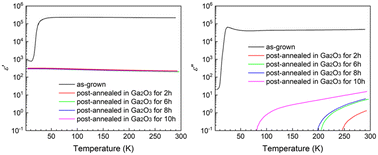Controlling dielectric properties of Nb + X (X = Al, Ga, In) co-doped and Nb-doped rutile-type TiO2 single crystals†
Abstract
Co-doping of heterovalent ions to rutile-type TiO2 has recently attracted attention as a new concept for designing high-permittivity materials with local structure engineering. However, the role of co-dopants in permittivity enhancement remains an open question. In the present study, dielectric measurements are performed in Nb + X (X = Al, Ga, In) co-doped and Nb-doped rutile-type TiO2 single crystals before and after annealing in X2O3 powders. The apparently huge permittivity, on the order of 105, is observed in all as-grown samples. Systematic analyses of dielectric relaxation observed in the as-grown samples clarify that thermally excited carriers render the sample semiconducting, thus giving rise to the apparently huge permittivity. In the post-annealed samples, in contrast, the huge permittivity disappears, and the dielectric loss markedly decreases to indicate recovery of the insulating property. X-ray fluorescence analyses show that the insulation recovery stems from migration of X cations into the single crystal, which is caused by the post-annealing. The post-annealing time dependence of the dielectric properties indicates that minute control of the Nb-to-X ratio is crucial for simultaneously achieving both the large permittivity and the fine insulating property in the co-doped TiO2. The present results offer an important clue toward clarifying the mechanism of permittivity boosting in co-doped TiO2.



 Please wait while we load your content...
Please wait while we load your content...